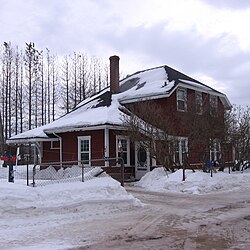Riverside-Albert | |
|---|---|
 Former train station in Riverside-Albert | |
| Coordinates: 45°45′5.1″N64°43′3.6″W / 45.751417°N 64.717667°W | |
| Country | Canada |
| Province | New Brunswick |
| County | Albert County |
| Parish | Hopewell Parish |
| Municipality | Fundy Albert |
| Incorporated | 1966 |
| Amalgamated | 2023 |
| Government | |
| • Type | Village council |
| Area | |
| • Land | 3.39 km2 (1.31 sq mi) |
| Population (2021) [1] | |
• Total | 348 |
| • Density | 102.8/km2 (266/sq mi) |
| • Change (2016–21) | |
| Electoral districts | |
| • Federal | Fundy Royal |
| • Provincial | Albert |
| Time zone | UTC-4 (Atlantic (AST)) |
| • Summer (DST) | UTC-3 (Atlantic (ADT)) |
| Canadian Postal code | |
| Area codes | 506, 428 |
| Telephone Exchange | 882 |
| Highway | |
| Website | http://www.riverside-albert.ca |
Riverside-Albert is a disincorporated village in Fundy Albert, New Brunswick, Canada. [2] [3] It resides in the geographic parish of Hopewell in Albert County.
Contents
Riverside-Albert is located on the north of Shepody River on upland above the marsh. The community of Harvey Parish is located across the river. It is approximately halfway between two major tourist destinations: Fundy National Park and the Hopewell Rocks.
Post office called Albert from 1875; Riverside from 1875 to 1932; Riverside from 1932.
The Trans Canada Trail passes through Riverside-Albert. [4]
